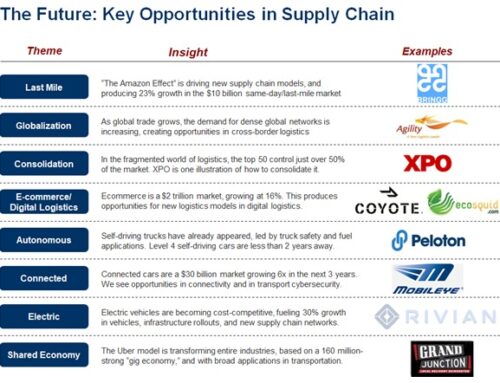Originally published by CNBC on February 5, 2015.
“An army marches on its stomach,” Napoleon famously said.
While the high-technology sector captures the headlines, the supply-chain sector is responsible for the heavy lifting, behind the scenes. The books, clothing, and goods that we purchase are increasingly made in Asia or Mexico; transported through multiple modes including air, ocean, rail and truck; passed through warehouses or cross-dock facilities; and delivered to your home via a last-mile delivery company.
The supply chain may not be glamorous, but it is a powerful indicator of the state of the economy. During the recessions of 1992, 2001, and 2008, the transportation sector was among the first to plummet, and in turn was among the fastest to recover.
So what is the supply-chain sector telling us today?
We just completed our ninth annual BG Strategic Advisors Supply Chain conference, convening over 200 of the top CEOs and investors in this market. Here are some of the takeaways for the industry – and what they mean for the economy:
A bullish transport forecast for 2015. in addition, The number of attendees predicting they will achieve growth in excess of 10 percent this year jumped to 63 percent from 54 percent a year ago. This builds on a strong 2014.
Cheap oil: A double-edged sword. The drop in crude prices has had a mixed effect: It’s putting more money in consumers’ pockets that cycle through the rest of the economy and it slashes operating costs for trucks, ships and railroads. However, it also lowers the expected volume of crude-by-rail transport, as well as the oil and gas rig counts in the lower 48 states of the United States, leading to a cut in the amount of domestic transportation associated with rigs. Going forward, we think cheaper oil will continue to boost margins for transportation companies, and play a positive role for the industry as a whole.
Labor constraints. The most common concern expressed by CEOs revolved around finding qualified staff. 44 percent expressed such concerns this year, up from 31 percent a year ago. Perhaps the biggest challenge is the driver shortage. We face a forecasted shortage of 240,000 by 2022. Why is that? For starters, not a lot of people want to drive trucks, and in good economic times, they have good alternatives.
Mexico. Increasingly, companies are choosing Mexico as a manufacturing hub. Mexico has more free trade agreements than any other country, a low-cost position, and immediate proximity to the US. 40 percent of survey respondents have already moved some operations to Mexico. 55 percent moved there from the US; 36 percent from China. As one CEO put it, “Mexico is no longer just about cheap parting. We are seeing real integration between the Mexican and US supply chains.” Companies are using Mexico as a part of their holistic strategy, including quality control, final assembly, exports, and other core services.
A booming deal market. 31 percent of all attendees said they were highly likely to engage in mergers and acquisitions, up from 24 percent last year.
Going forward, we believe the growth in the supply-chain sector is a bullish sign for the broader economy. The back-of-the-house successes are fueling front-of-the-house glory. And the transport industry is poised for another year of growth.
Commentary by Benjamin Gordon, managing partner of BG Strategic Advisors (“BGSA”). BGSA is a leading global investment banking firm specializing in M&A advisory services for companies in the transportation, logistics and supply-chain sectors. BGSA provides investment-banking services through BG Strategic Advisors, a registered broker-dealer and member of FINRA and the SIPC.











